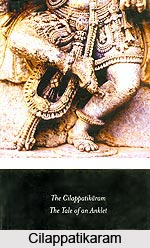 Kannaki or Kannagi is the fictional central character of Cilappatikaram, one of the Five Great Epics of Tamil literature of Sangam age. Kannaki is a celebrated Tamil woman who is much respected by the Tamil people. According to the epic written by Ilanko Atikal (Ilango Adigal), Kannaki took vengeance on the ruler of Madurai for mistakenly punishing her innocent husband named Kovalan by imposing a death penalty on him. Kannaki cursed the entire city of Madurai with a grave disaster. Kannaki Amman or Kannagi is extolled and lauded as the quintessence of chastity and is worshipped as a goddess all over the Tamil country. She is eulogised for her tremendous dedication and loyalty to her husband Kovalan despite of his disloyal behaviour. She is worshiped as Attukal Bhagavathy and Kodungallur Bhagavathy in the South Indian state ofKerala. In Sri Lanka, Kannaki is venerated as goddess Pattini (Pattini worship) by the Sinhalese Buddhists.
Kannaki or Kannagi is the fictional central character of Cilappatikaram, one of the Five Great Epics of Tamil literature of Sangam age. Kannaki is a celebrated Tamil woman who is much respected by the Tamil people. According to the epic written by Ilanko Atikal (Ilango Adigal), Kannaki took vengeance on the ruler of Madurai for mistakenly punishing her innocent husband named Kovalan by imposing a death penalty on him. Kannaki cursed the entire city of Madurai with a grave disaster. Kannaki Amman or Kannagi is extolled and lauded as the quintessence of chastity and is worshipped as a goddess all over the Tamil country. She is eulogised for her tremendous dedication and loyalty to her husband Kovalan despite of his disloyal behaviour. She is worshiped as Attukal Bhagavathy and Kodungallur Bhagavathy in the South Indian state ofKerala. In Sri Lanka, Kannaki is venerated as goddess Pattini (Pattini worship) by the Sinhalese Buddhists.
Kannaki or Kannagi is also idolized as a brave woman who demanded justice directly from the King of Madurai and even taunted him as the unenlightened king (Thera Manna, Vazhakkurai Kathai, Cilappatikaram).
Story of Kannaki
Kovalan was the son of a rich merchant in Kaveripattinam who was married to a young lady of legendary beauty named Kannaki. The couple lived together happily in Kaveripattinam city, but eventually Kovalan fell in love with a dancer named Madhavi. Kovalan spent all his wealth on Madhavi and forgot Kannaki. But after all his wealth was gone, he realised his mistake and returned to his wife. Kannaki forgave Kovalan and accepted him back. The only asset that the couple had was a pair of precious anklets, known as cilambu. The anklets which contained many gems were willingly given to Kovalan by Kannaki. They went to the city of Madurai with the hope of selling the anklets and recover his wealth through trade.
Madurai was under the rule of Nedunj Cheliyan I, the Pandya king. Kovalan decided to sell the anklets in order give their lives a fresh start. But during that period of time, one anklet out of a pair of anklets that belonged to the queen, was stolen by a court member. The appearance of the queen`s anklet was very similar to that of Kannaki`s anklets, the only difference between them was that Kannaki`s anklets were packed with rubies and the queen`s anklets adorned with pearls. When Kovalan went to sell his wife`s anklets in the market, he was blamed of stealing the queen`s anklets and without trial; Kovalan was instantaneously beheaded by the royal guards.
Kannaki became infuriated after she found out the bitter truth about her husband`s fate. She set out to prove Kovalan`s innocence to the ruler of Madurai. When she reached the royal court, she broke the anklet apprehended from her husband and revealed that the anklet had rubies, instead of pearls that were inside the queen`s anklets. The King and the Queen died of shame when they realized their mistake. But Kannaki was still not satisfied and demanded justice. She tore out a breast and threw it on the city and cursed that the city of Madurai will be burnt to ashes and only the elderly, the disabled and the children will be spared. The curse came true due to Kannaki`s supreme chastity. The city of Madurai was engulfed in flames which resulted in huge losses both in terms of human lives and economy. Finally the Goddess of the city requested Kannaki to withdraw her curse, which she did and later achieved salvation. After the incident at Madurai city, Kannaki reached Kodungalloor and lived in Kodungallur Bhagavathy Temple south of Guruvayoor.
The events related to Kannaki, as depicted by Ilanko Atikal (Ilango Adigal) in his Tamil epic Cilappatikaram, have deeply influenced the traditions, customs and culture of Kerala and Tamil Nadu.



















